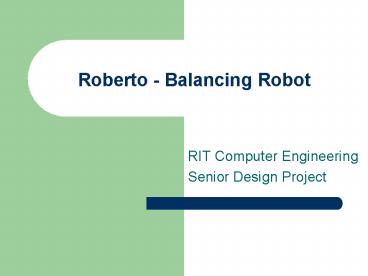Roberto - Balancing Robot - PowerPoint PPT Presentation
1 / 20
Title:
Roberto - Balancing Robot
Description:
Dave Froman. Project Description. Two-wheel balancing robot. Balances on any angled surface ... Means to control some output from a combination of different factors ... – PowerPoint PPT presentation
Number of Views:2450
Avg rating:5.0/5.0
Title: Roberto - Balancing Robot
1
Roberto - Balancing Robot
- RIT Computer Engineering
- Senior Design Project
2
Group Members
- Jeff Mahmood
- Paul Krausman
- Dave Froman
3
Project Description
- Two-wheel balancing robot
- Balances on any angled surface
- Remains balances indefinitely
- Remote controlled
- Inverted Pendulum
- PID Controller
4
Physical Layout
5
PID Algorithm
- Means to control some output from a combination
of different factors - Differential equations solved in the frequency
domain - We will solve experimentally
6
PID Algorithm (cont.)
- PID is Proportional Integral Derivative
- Output based on the aggravate of 3 factors
- Error
- Error Derivative
- Error Integral
- PID algorithm combines these 3 factors to
determine appropriate output
7
Error Definition
- Error Difference between set point and actual
- Error can be positive or negative
Set Point
Error
Actual
8
PID Equation
- Proportional Integral Derivative
- Output PT IT DT
- P is the Proportional constant
- Current error
- I is Integral constant
- Sum of past errors
- D is Derivative constant
- Rate of change of error
9
Proportional
- Torque applied to motors is proportional to
amount of error
0
T
40
10
Integral
- Sum of all errors over time
- Biases output so all errors cancel over time
11
Derivative
- Torque applied to motors proportional to
derivative of error - Velocity of error
0
300/sec
12
Tuning PID Controllers
- Goal
- Find coefficients for P, I, and D terms
- Robot should snap back to set point after any
disturbances - Prevent any oscillations
- Robot should remain at set point indefinitely
13
Finding P Term
- Set I and D terms to 0
- Set P term to 1
- Increase P term until strong oscillations occur
- Some references recommend setting P to 60 of
this value
14
Finding D Term
- Slowly increase D until oscillations begin to
slow - Fine-tune D
- Robot will oscillate if D is too high
- Robot will fall over is D is too low
- Robot should snap back to set point after any
disturbances
15
Finding I Term
- More difficult than P and D
- Generally inverse of D
- Limit sum to prevent saturation
- Sliding window
16
Increase Performance
- Robot may seem sluggish
- If either P or D is set too low, robot will be
slow to respond - Robot may oscillate
- If either P or D is set too high, robot will
oscillate before settling on set point - Tweak P and D terms until optimal performance is
achieved
17
Sensors
- Accelerometer
- Measures tilt (proportional error)
- Slow response, but accurate
- Gives sense of up
- Gyro
- Measures velocity (derivative error)
- Fast response, but inaccurate
- Suffers from drift over time
18
User Interface - Remote Control
- Two axis control left and right motors
- 2 commands for each side move forward, back
- Uses 4 bit encoding/decoding(8 values used)
- Each switch press has unique encode value, which
is transmitted and received
19
Remote Control
- Momentary rocker switches are used for intuitive
remote controlled car feel - Robot moves by pressing both switches in the same
direction, turns by alternating directions
20
The End
- Questions???
















![Forecast on China Industrial Robot Industry[2015-2019] PowerPoint PPT Presentation](https://s3.amazonaws.com/images.powershow.com/8334715.th0.jpg?_=20190501113)














